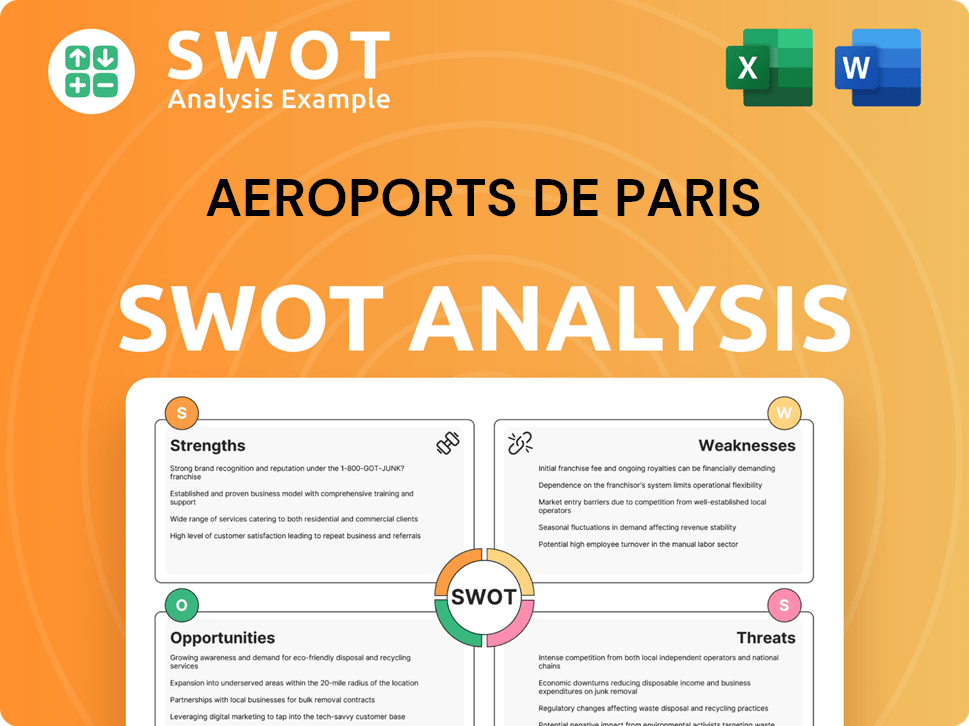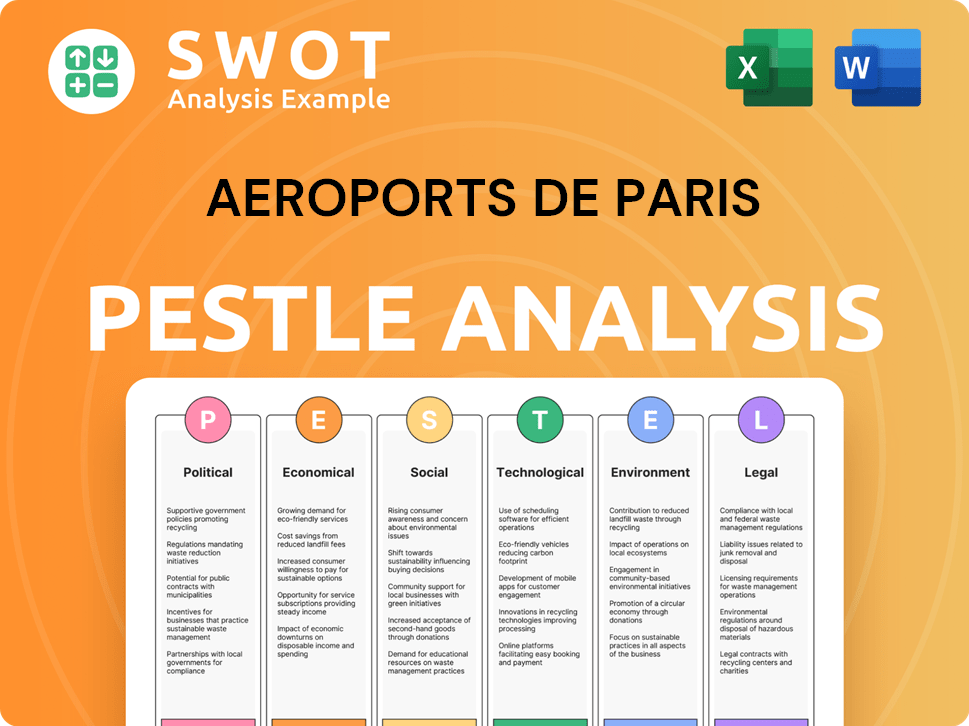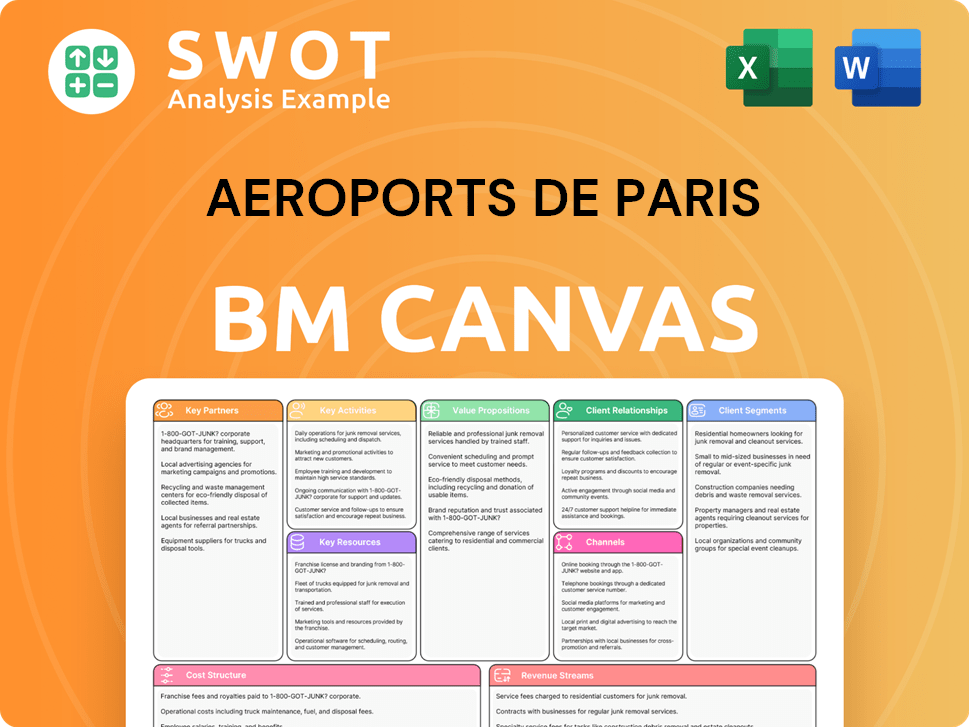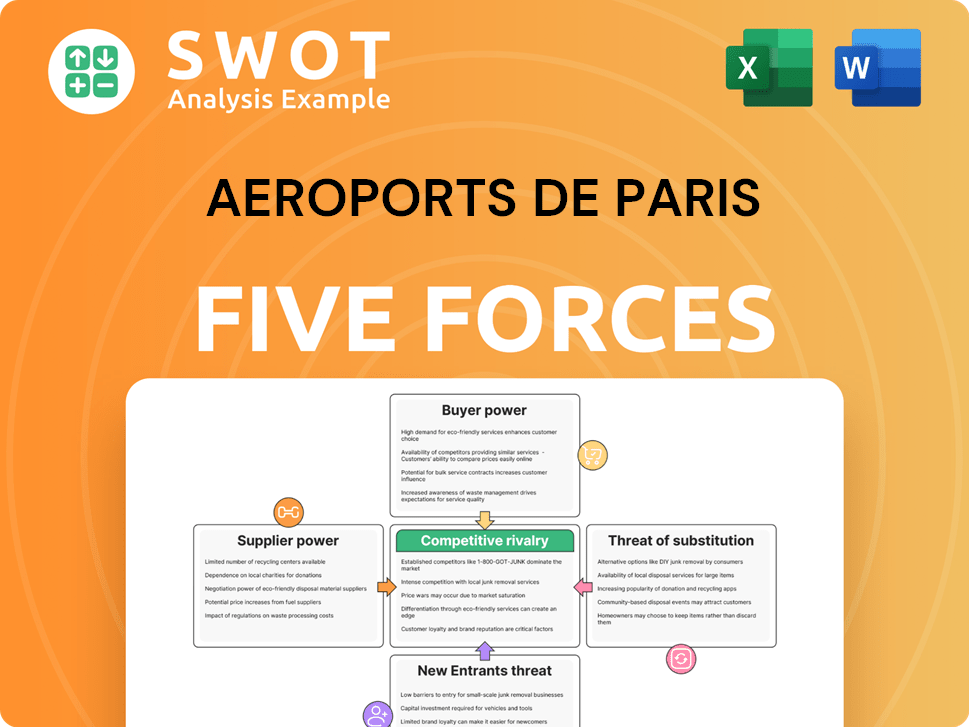Aeroports de Paris Bundle
Who Really Controls Aeroports de Paris?
Unraveling the ownership of Aéroports de Paris (ADP) is key to understanding its strategic direction and future potential. The company, a global leader in airport operations, has a fascinating ownership structure that blends public and private interests. This unique mix has significant implications for investors, stakeholders, and the overall economy.

Understanding the intricacies of Aeroports de Paris SWOT Analysis and its ADP ownership structure is crucial for anyone navigating the complexities of the aviation industry and the Paris airports. Groupe ADP's evolution from a public entity to its current hybrid model reflects broader trends in privatization and the interplay between government control and market forces. Examining who owns ADP, including its major shareholders, provides essential insights into its financial information, strategic decision-making, and long-term value creation.
Who Founded Aeroports de Paris?
The establishment of Aéroports de Paris (ADP), now known as Groupe ADP, on October 24, 1945, marked the beginning of a significant entity in the management of Paris airports. Understanding the initial ownership structure provides crucial context for its evolution. This early phase set the stage for how the company would operate and develop over the following decades.
ADP's inception was as a public industrial and commercial establishment (Établissement public à caractère industriel et commercial - EPIC) by the French government. This designation meant that its ownership was entirely public, reflecting its strategic importance to the nation. The French State, acting through various ministries, held complete control.
The initial ownership of Aeroports de Paris was straightforward: the French government held 100% of the shares. This structure ensured that the development of airport infrastructure aligned with national strategic goals. The focus was on post-war economic recovery and international connectivity.
ADP was established as an EPIC, a public entity. This meant it was not a privately funded company.
The French State held 100% of the shares at the beginning. The government's role was to manage and develop the Parisian airport system.
Capital was provided by the state, with the aim to serve public interest. Early agreements did not involve vesting schedules.
The primary goal was to create a unified authority for the airport system. This was crucial for national economic recovery.
As an EPIC, ADP operated on commercial principles while serving public interest. This framework shaped its operations.
There were no initial ownership disputes, as the French State unequivocally held control. This simplified early management.
The early structure of ADP, with 100% state ownership, was designed to support national interests. This model ensured that the development of Paris airports aligned with strategic goals. The absence of private shareholders or early investors reflects its public service mandate.
- The French government initially fully owned Aeroports de Paris.
- The company's legal structure as an EPIC determined its funding and operational focus.
- Early agreements did not involve private equity concepts like vesting or buyouts.
- The primary goal was to create a unified authority for the airport system.
Aeroports de Paris SWOT Analysis
- Complete SWOT Breakdown
- Fully Customizable
- Editable in Excel & Word
- Professional Formatting
- Investor-Ready Format

How Has Aeroports de Paris’s Ownership Changed Over Time?
The ownership structure of Aéroports de Paris (ADP), now known as Groupe ADP, has evolved significantly. Initially, it was a state-owned entity. A pivotal moment was the partial privatization and listing on the Euronext Paris stock exchange on June 16, 2006. This initial public offering (IPO) brought private shareholders into the mix, although the French State maintained a majority stake. This shift introduced institutional investors, mutual funds, and individual shareholders to the company.
The IPO of ADP marked a crucial turning point, transforming its financial and operational landscape. This change introduced a dual objective: serving the public interest while also delivering shareholder value. This led to a greater emphasis on profitability and international expansion, impacting strategic decisions and governance within the company. This transformation is a key element in understanding the current ADP ownership structure and its strategic direction, as highlighted in the Growth Strategy of Aeroports de Paris.
| Shareholder | Approximate Stake (as of December 31, 2024) | Type |
|---|---|---|
| French State | 50.6% | Government |
| BlackRock, Inc. | Significant | Institutional Investor |
| Capital Research Global Investors | Significant | Institutional Investor |
| Norges Bank Investment Management (NBIM) | Significant | Institutional Investor |
As of the end of 2024, the French State remains the largest shareholder in Groupe ADP, holding approximately 50.6% of the capital. This significant stake underscores the government's continued strategic interest in the company and its importance to national infrastructure. Other major shareholders include institutional investors like BlackRock, Inc., Capital Research Global Investors, and Norges Bank Investment Management (NBIM). These institutional investors hold substantial portions of the floating stock, influencing the company's direction through their investment strategies.
The ownership of Groupe ADP is a mix of public and private interests, with the French State as the primary shareholder. The IPO in 2006 was a key event, opening the door to private investment.
- The French State holds a majority stake, ensuring government influence.
- Institutional investors play a significant role in the shareholder base.
- The ownership structure influences the company's strategic objectives.
- Understanding the ownership is crucial for assessing ADP's future.
Aeroports de Paris PESTLE Analysis
- Covers All 6 PESTLE Categories
- No Research Needed – Save Hours of Work
- Built by Experts, Trusted by Consultants
- Instant Download, Ready to Use
- 100% Editable, Fully Customizable

Who Sits on Aeroports de Paris’s Board?
The current board of directors of Groupe ADP, also known as Aeroports de Paris, reflects its mixed ownership. As of early 2025, the board includes members appointed by the French State, employee representatives, and independent directors chosen for their expertise. The Chairman and CEO, currently Augustin de Romanet, is appointed by presidential decree, indicating the strong influence of the state.
The composition of the board ensures a balance between state interests and operational expertise. The presence of independent directors aims to bring diverse perspectives and contribute to effective governance. This structure is a key aspect of understanding the ADP ownership and how decisions are made within the company.
| Board Member | Role | Affiliation |
|---|---|---|
| Augustin de Romanet | Chairman and CEO | Appointed by French President |
| Employee Representatives | Various | Employee Unions |
| Independent Directors | Various | Independent Experts |
The voting structure of ADP is primarily based on the one-share-one-vote principle. However, the French State, as the majority shareholder, holds over 50% of the voting rights, giving it effective control. This allows the state to influence strategic decisions, including major investments and the appointment of key executives. The state's significant stake ensures its ability to shape the company's direction, which is crucial for understanding who controls Aeroports de Paris.
The French State's majority ownership significantly influences strategic decisions at Groupe ADP. This control is a key factor in understanding the ADP ownership structure and its impact on the company's operations. Explore the Revenue Streams & Business Model of Aeroports de Paris to learn more about the company.
- The French State holds over 50% of voting rights.
- The Chairman and CEO are appointed by the French President.
- Employee representatives also sit on the board.
- Independent directors provide diverse expertise.
Aeroports de Paris Business Model Canvas
- Complete 9-Block Business Model Canvas
- Effortlessly Communicate Your Business Strategy
- Investor-Ready BMC Format
- 100% Editable and Customizable
- Clear and Structured Layout

What Recent Changes Have Shaped Aeroports de Paris’s Ownership Landscape?
Over the past few years (2022-2025), the ownership structure of Groupe ADP, also known as Aeroports de Paris, has remained largely stable, with the French State maintaining its majority stake. While there haven't been significant share buybacks or major public offerings to drastically shift ownership percentages, there's been ongoing trading activity among institutional investors. These adjustments often reflect market conditions, sector outlooks, and portfolio rebalancing strategies.
A key consideration impacting ADP's ownership is the potential for further privatization of the French State's holdings. Although a full privatization plan was initiated in 2019, it was paused due to market volatility and the COVID-19 pandemic's impact on air travel. The possibility of the state reducing its share remains a recurring topic in financial and political discussions. This trend aligns with broader industry trends where governments consider divesting stakes to raise capital or improve efficiency through private sector involvement. Any changes in government policy could significantly influence ADP's ownership.
| Shareholder | Approximate Ownership (as of early 2024) | Notes |
|---|---|---|
| French State | 50.6% | Majority shareholder, controlling stake. |
| Institutional Investors | Approximately 44% | Includes various investment funds and financial institutions. |
| Employee Shareholders | Around 0.5% | Employee stock ownership plans. |
| Free Float | Approximately 4.9% | Shares available for public trading. |
The company's public statements often focus on its long-term strategy and international expansion, which could necessitate capital adjustments that might indirectly lead to ownership shifts if new strategic investors are sought. Understanding the Target Market of Aeroports de Paris is crucial for investors assessing the company's future prospects and potential ownership changes.
The French State is the primary owner of Aeroports de Paris, holding a majority stake. Institutional investors account for a significant portion of the remaining shares.
There have been no significant changes in the ownership structure recently, but discussions regarding potential privatization continue. Ongoing trading among institutional investors is common.
The French State, institutional investors, and employee shareholders are the main stakeholders in ADP. The free float represents a small percentage of the total shares.
ADP's strategic plans, including international expansion, could influence future ownership dynamics. The government's stance on privatization remains a key factor.
Aeroports de Paris Porter's Five Forces Analysis
- Covers All 5 Competitive Forces in Detail
- Structured for Consultants, Students, and Founders
- 100% Editable in Microsoft Word & Excel
- Instant Digital Download – Use Immediately
- Compatible with Mac & PC – Fully Unlocked

Related Blogs
- What are Mission Vision & Core Values of Aeroports de Paris Company?
- What is Competitive Landscape of Aeroports de Paris Company?
- What is Growth Strategy and Future Prospects of Aeroports de Paris Company?
- How Does Aeroports de Paris Company Work?
- What is Sales and Marketing Strategy of Aeroports de Paris Company?
- What is Brief History of Aeroports de Paris Company?
- What is Customer Demographics and Target Market of Aeroports de Paris Company?
Disclaimer
All information, articles, and product details provided on this website are for general informational and educational purposes only. We do not claim any ownership over, nor do we intend to infringe upon, any trademarks, copyrights, logos, brand names, or other intellectual property mentioned or depicted on this site. Such intellectual property remains the property of its respective owners, and any references here are made solely for identification or informational purposes, without implying any affiliation, endorsement, or partnership.
We make no representations or warranties, express or implied, regarding the accuracy, completeness, or suitability of any content or products presented. Nothing on this website should be construed as legal, tax, investment, financial, medical, or other professional advice. In addition, no part of this site—including articles or product references—constitutes a solicitation, recommendation, endorsement, advertisement, or offer to buy or sell any securities, franchises, or other financial instruments, particularly in jurisdictions where such activity would be unlawful.
All content is of a general nature and may not address the specific circumstances of any individual or entity. It is not a substitute for professional advice or services. Any actions you take based on the information provided here are strictly at your own risk. You accept full responsibility for any decisions or outcomes arising from your use of this website and agree to release us from any liability in connection with your use of, or reliance upon, the content or products found herein.